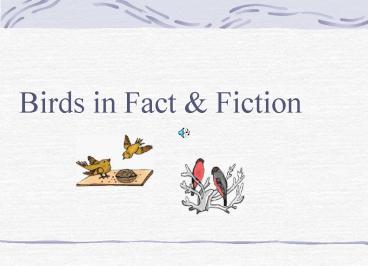Birds in Fact - PowerPoint PPT Presentation
1 / 19
Title:
Birds in Fact
Description:
Title: PowerPoint Presentation Author: WVHTC Foundation Training Cen Last modified by: Technology Created Date: 4/1/2000 5:22:11 PM Document presentation format – PowerPoint PPT presentation
Number of Views:124
Avg rating:3.0/5.0
Title: Birds in Fact
1
Birds in Fact Fiction
2
Bird Study
- Identify species
- Identify body parts
- Identify habitats
- Identify migration
- Appreciate these living creatures
3
Language Arts
- Read a novel
- Read and appreciate bird tales from around the
world - Read a poem
- Write a poem
- Write a play
4
Trumpet of the SwanBy E.B. White
- A family of swans live on Red Rock Lakes in
Montana. - Louis is a cygnet born without a voice.
- Louiss father steals a trumpet to help his son.
- Louis leaves home to find a way to pay for the
trumpet. - Louis learns to depend on his friend, Sam Beaver.
- Louis tries to find a way back to his love,
Serena.
5
What Makes a Bird a Bird?
- A bird has wings.
- A bird has a beak.
- A bird has special feet.
- A bird has feathers.
6
Beaks Enable Birds to Eat
- A long narrow beak works like a straw.
- A short thick beak easily picks up grain.
- A sharp hooked beak can tear meat.
- A thick large beak can crack shells of nuts.
- A flat large beak sifts water and gathers plants.
7
Birds are Consumers
- Birds must eat (consume) a lot of food (energy)
each day. - Birds can be herbivores (plant eaters),
carnivores (meat eaters) or omnivores (eat plants
and meats).
8
Bird Sites
- Zoom School Birds and Dinosaurs
- Audubon Society
- Cornell University Lab of Ornithology
- GeoZoo Birds!
- The National Birds of Prey Center
- Unit and Lesson Plans
9
Bird Feet
- Birds have two feet.
- Grasping feet are large, curved claws to snatch
prey. - Scratching feet have long thin claws to search in
the soil for grains and seeds. - Webbed feet enable water birds to use their feet
like paddles - Perching feet help birds grasp branches tightly.
- Climbing feet help birds get a good grip on tree
trunks as they climb.
10
Birds in Motion
- There are three types of flight flapping,
gliding, and hovering. - All birds dont fly.
- Some birds use their wings to swim.
- Some birds walk or run.
11
Greater Backyard Birdwatch
- Observe birds for three days
- Identify species
- Post results to Ornithology Lab of Cornell
University
12
What is an ornithologist?
13
Ornithologist for the Day
- Bird watching is an inexpensive, simple hobby.
- You will need a field guide reference book,
binoculars, a pencil, and a small notebook.
- Find a comfortable spot near a place birds
gather. - Observe birds as they gather and feed.
- Best times are early morning or just before
sunset.
14
Bird Watching
Day 1 Time/Place Bird Name Color Markings
Day 2
Day 3
15
Activities
- Class Bird Book
- Class Bird List
- Feather Fun
- Microscope Magic
- Special Speaker
- Make Fantastic Feeder for your Feathered Friends
- Water on the Ducks Back
- Adaptations of water birds
- You Need the Right Bill for the Job!
- Bird Feet are Special Feet
16
Family Facts
- Some birds build nests in trees, others build
nests on the ground. - Not all baby birds are helpless when they are
born. - Chicks are babies born to birds that build nests
on the ground. Soon after they hatch they are
all fluffy. They can see and run around looking
for food. - Ducklings run after their mother. They learn
what to eat and how to swim. - A baby duck learns its mother by an instinct
called imprinting.
17
Dissect An Egg
- Parts of an egg are
- eggshell is strong to protect growing baby
- lining (membrane) lines the eggshell to prevent
the egg from drying out - egg white (albumen) is mostly water
- yolk is the yellow center and is full of food for
the baby bird - cloraza are the twisted strings that keep the
yolk suspended and absorb any bumps or knocks - white spot is on the yolk and is where an embryo
will attach during development - It is hard work to break out of a shell. A
person should never help. This robs the baby
bird of developing strength to survive.
18
Day or Night?
- Birds that actively look for food during the day
are called diurnal. Robins are an example
- Some birds are up all night searching the
darkness for food. They are called nocturnal.
Owls are an example.
19
Migration
- Many birds live in places that get very cold in
winter. - They fly away to warmer places to find food.
- They return again in the spring to lay their
eggs. - Birds have instinct so they dont get lost!

